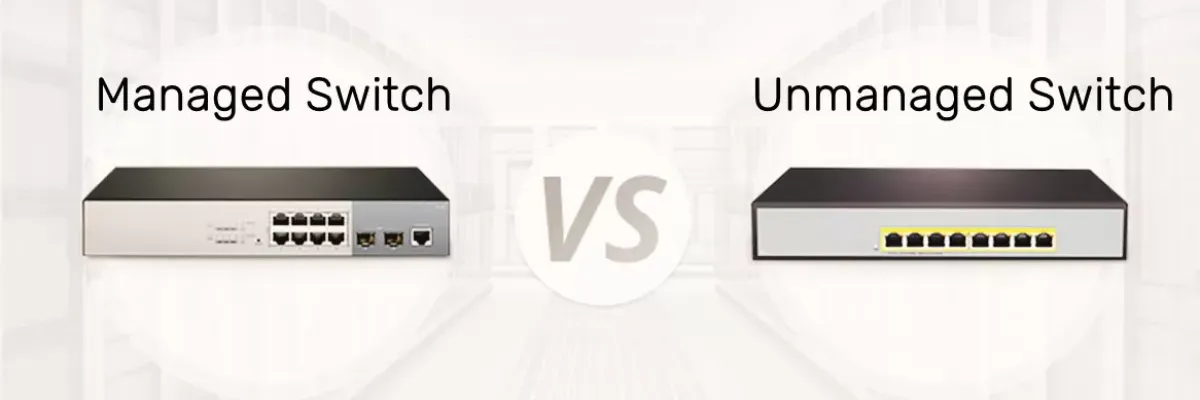
Introduction of an unmanaged switch
An unmanaged switch is a basic network switch that is designed to provide plug-and-play connectivity for devices in a local area network (LAN). It is a simple, low-cost networking solution that requires no configuration or management.
Unmanaged switches are typically used in small home or office networks where there is no need for advanced network management or customization options. They operate automatically, forwarding data packets between devices connected to them without any intervention or control from the user.
The Difference Between Managed and Unmanaged Switch?
A switch is a networking device that connects multiple devices together within a local area network (LAN) to enable communication and data transfer between them. There are two types of switches: managed and unmanaged.
The main difference between a managed and unmanaged switch is the level of control and configuration options that they offer.
An unmanaged switch is a plug-and-play device that requires no configuration or management. It operates automatically and has no user interface or configuration options. It is simply a network switch that provides basic connectivity between devices.
A managed switch, on the other hand, offers more control and customization options. It provides a user interface and configuration options that allow network administrators to manage and control network traffic, prioritize bandwidth for certain applications, and monitor network performance.
Managed switches can also offer advanced features such as VLANs (virtual local area networks), Quality of Service (QoS) for traffic prioritization, port mirroring for traffic analysis, and more.
What are the advantages of using an unmanaged switch?
There are several advantages to using an unmanaged switch, including:
Easy to set up:
Unmanaged switches are typically plug-and-play devices that require no configuration or setup. They are designed to be easy to use, even for users with limited networking experience.
Cost-effective:
Unmanaged switches are generally less expensive than managed switches. They are a cost-effective solution for small networks with a limited number of devices.
Reliable:
Unmanaged switches are designed to be simple and reliable. They operate automatically and require no user intervention, which reduces the risk of configuration errors or other issues.
Low maintenance:
Because unmanaged switches require no management, they are low maintenance devices. There is no need for regular updates or maintenance tasks, which can save time and resources.
Scalability:
Unmanaged switches can be easily added to a network to expand the number of devices that can be connected. They are a scalable solution for small networks that need to grow over time.
What factors should be considered when choosing between managed and unmanaged switches?
When choosing between managed and unmanaged switches
Network size:
The size of your network is an important consideration when choosing a switch. Unmanaged switches are suitable for small networks with a limited number of devices, while managed switches are better suited for larger networks with a higher number of devices.
Network complexity:
If your network requires advanced features such as VLANs, Quality of Service (QoS), or port mirroring, a managed switch is the better choice. Unmanaged switches do not offer these features.
IT expertise:
Managed switches require more IT expertise to configure and manage. If your organization has IT personnel with networking experience, a managed switch may be a good choice. If not, an unmanaged switch may be easier to use and maintain.
Cost:
Managed switches are typically more expensive than unmanaged switches. If cost is a concern, an unmanaged switch may be the more cost-effective option.
Security:
Managed switches offer greater security options such as access control, VLANs, and traffic monitoring, which can be important in environments where security is a concern. Unmanaged switches do not offer these features.
Performance:
Managed switches provide better performance and throughput, which can be important in high-demand environments such as data centers or enterprise networks.
Which type of switch is best for my network?
The type of switch that is best for your network depends on the specific needs and requirements of your organization.
Small networks:
For small networks with a limited number of devices, an unmanaged switch may be sufficient. They are easy to set up and operate, and they are cost-effective.
Large networks:
For larger networks with a higher number of devices, a managed switch is recommended. Managed switches offer advanced features such as VLANs, Quality of Service (QoS), and port mirroring, which are essential for managing larger and more complex networks.
Security:
If security is a concern, a managed switch is recommended. Managed switches offer greater security options such as access control, VLANs, and traffic monitoring, which can be important in environments where security is a concern.
Performance:
If performance is a priority, a managed switch is recommended. Managed switches provide better performance and throughput, which can be important in high-demand environments such as data centers or enterprise networks.
IT expertise:
Managed switches require more IT expertise to configure and manage. If your organization has IT personnel with networking experience, a managed switch may be a good choice. If not, an unmanaged switch may be easier to use and maintain.
Conclusion
In conclusion, switches are an essential component of computer networks, allowing devices to communicate with each other and share resources. There are two main types of switches: managed and unmanaged.
Unmanaged switches are designed for simple networks with a limited number of devices. They are easy to set up and operate cost-effective, reliable, and low maintenance. However, they offer no advanced features such as VLANs, QoS, or port mirroring.

Leave a Comment